(完整版)语法精讲:be+动词不定式(用法9种)
- 格式:doc
- 大小:14.51 KB
- 文档页数:2

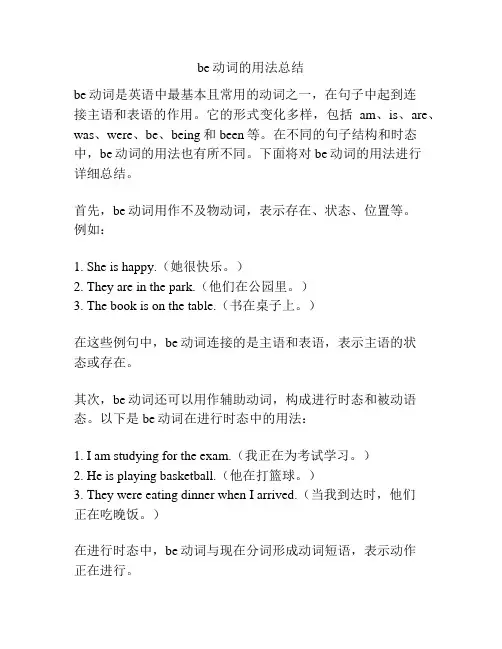
be动词的用法总结be动词是英语中最基本且常用的动词之一,在句子中起到连接主语和表语的作用。
它的形式变化多样,包括am、is、are、was、were、be、being和been等。
在不同的句子结构和时态中,be动词的用法也有所不同。
下面将对be动词的用法进行详细总结。
首先,be动词用作不及物动词,表示存在、状态、位置等。
例如:1. She is happy.(她很快乐。
)2. They are in the park.(他们在公园里。
)3. The book is on the table.(书在桌子上。
)在这些例句中,be动词连接的是主语和表语,表示主语的状态或存在。
其次,be动词还可以用作辅助动词,构成进行时态和被动语态。
以下是be动词在进行时态中的用法:1. I am studying for the exam.(我正在为考试学习。
)2. He is playing basketball.(他在打篮球。
)3. They were eating dinner when I arrived.(当我到达时,他们正在吃晚饭。
)在进行时态中,be动词与现在分词形成动词短语,表示动作正在进行。
而在被动语态中,be动词与过去分词形成动词短语,将动作的承受者放在句子的主语位置。
例如:1. The book is written by a famous author.(这本书是由一位著名作家写的。
)2. The movie was watched by millions of people.(这部电影被数百万人观看。
)除了以上两种用法外,be动词还可以表示习惯、性格、身份等一些特定的含义。
例如:1. He is always late for work.(他上班总是迟到。
)2. My sister is a doctor.(我妹妹是一名医生。
)3. She is a kind person.(她是个善良的人。
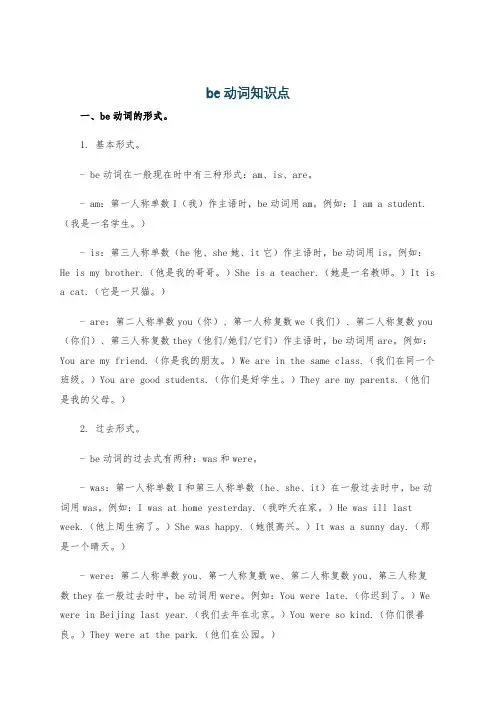
be动词知识点一、be动词的形式。
1. 基本形式。
- be动词在一般现在时中有三种形式:am、is、are。
- am:第一人称单数I(我)作主语时,be动词用am。
例如:I am a student.(我是一名学生。
)- is:第三人称单数(he他、she她、it它)作主语时,be动词用is。
例如:He is my brother.(他是我的哥哥。
)She is a teacher.(她是一名教师。
)It is a cat.(它是一只猫。
)- are:第二人称单数you(你)、第一人称复数we(我们)、第二人称复数you (你们)、第三人称复数they(他们/她们/它们)作主语时,be动词用are。
例如:You are my friend.(你是我的朋友。
)We are in the same class.(我们在同一个班级。
)You are good students.(你们是好学生。
)They are my parents.(他们是我的父母。
)2. 过去形式。
- be动词的过去式有两种:was和were。
- was:第一人称单数I和第三人称单数(he、she、it)在一般过去时中,be动词用was。
例如:I was at home yesterday.(我昨天在家。
)He was ill last week.(他上周生病了。
)She was happy.(她很高兴。
)It was a sunny day.(那是一个晴天。
)- were:第二人称单数you、第一人称复数we、第二人称复数you、第三人称复数they在一般过去时中,be动词用were。
例如:You were late.(你迟到了。
)We were in Beijing last year.(我们去年在北京。
)You were so kind.(你们很善良。
)They were at the park.(他们在公园。
)二、be动词的用法。
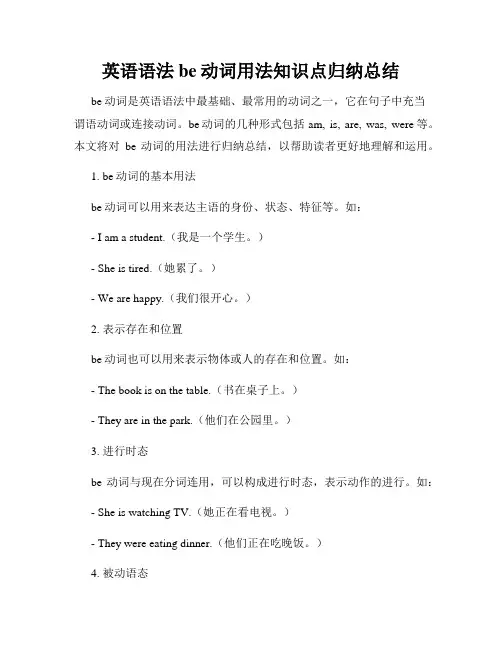
英语语法be动词用法知识点归纳总结be动词是英语语法中最基础、最常用的动词之一,它在句子中充当谓语动词或连接动词。
be动词的几种形式包括am, is, are, was, were等。
本文将对be动词的用法进行归纳总结,以帮助读者更好地理解和运用。
1. be动词的基本用法be动词可以用来表达主语的身份、状态、特征等。
如:- I am a student.(我是一个学生。
)- She is tired.(她累了。
)- We are happy.(我们很开心。
)2. 表示存在和位置be动词也可以用来表示物体或人的存在和位置。
如:- The book is on the table.(书在桌子上。
)- They are in the park.(他们在公园里。
)3. 进行时态be动词与现在分词连用,可以构成进行时态,表示动作的进行。
如:- She is watching TV.(她正在看电视。
)- They were eating dinner.(他们正在吃晚饭。
)4. 被动语态be动词与过去分词连用,可以构成被动语态,表示主语是动作的承受者。
如:- The car was repaired by a mechanic.(这辆车被一个机修工修好了。
)- The movie is loved by many people.(这部电影被很多人喜欢。
)5. 时态和人称的变化be动词的时态和人称会根据具体情况发生变化。
如:- I am.(我是。
)- She is.(她是。
)- They were.(他们是。
)6. 否定形式be动词的否定形式是在be动词前加not,即is not, am not, are not, was not, were not等。
如:- He is not here.(他不在这里。
)- We were not late.(我们没有迟到。
)7. 疑问形式be动词的疑问形式是将be动词置于句首,即Is he...? Am I...? Are they...? Was she...? Were we...?等。
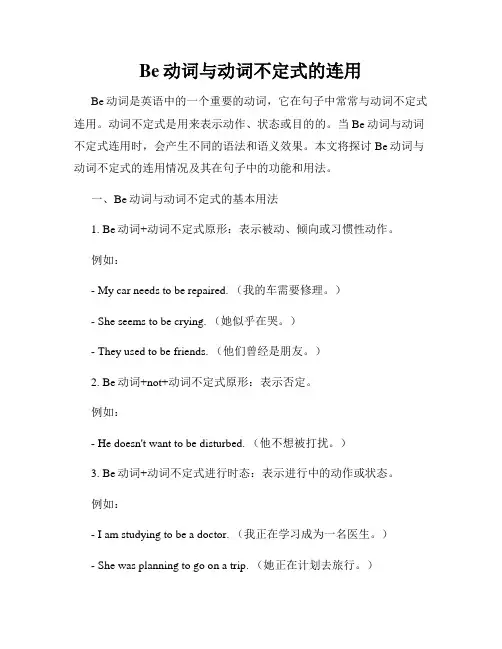
Be动词与动词不定式的连用Be动词是英语中的一个重要的动词,它在句子中常常与动词不定式连用。
动词不定式是用来表示动作、状态或目的的。
当Be动词与动词不定式连用时,会产生不同的语法和语义效果。
本文将探讨Be动词与动词不定式的连用情况及其在句子中的功能和用法。
一、Be动词与动词不定式的基本用法1. Be动词+动词不定式原形:表示被动、倾向或习惯性动作。
例如:- My car needs to be repaired. (我的车需要修理。
)- She seems to be crying. (她似乎在哭。
)- They used to be friends. (他们曾经是朋友。
)2. Be动词+not+动词不定式原形:表示否定。
例如:- He doesn't want to be disturbed. (他不想被打扰。
)3. Be动词+动词不定式进行时态:表示进行中的动作或状态。
例如:- I am studying to be a doctor. (我正在学习成为一名医生。
)- She was planning to go on a trip. (她正在计划去旅行。
)二、Be动词与动词不定式的句型变化1. Be动词与动词不定式的一般句型:主语 + Be动词 + 动词不定式例如:- I want to be a teacher. (我想成为一名老师。
)- You need to be more careful. (你需要更小心一些。
)2. Be动词与动词不定式进行时态的句型:主语 + Be动词 + 动词不定式进行时态例如:- He is considering to start his own business. (他正在考虑创业。
)- We were hoping to meet you at the party. (我们希望在派对上见到你。
)三、Be动词与动词不定式的用法特点1. Be动词与动词不定式连用时,常用于表示愿望、打算、能力、义务等情况。
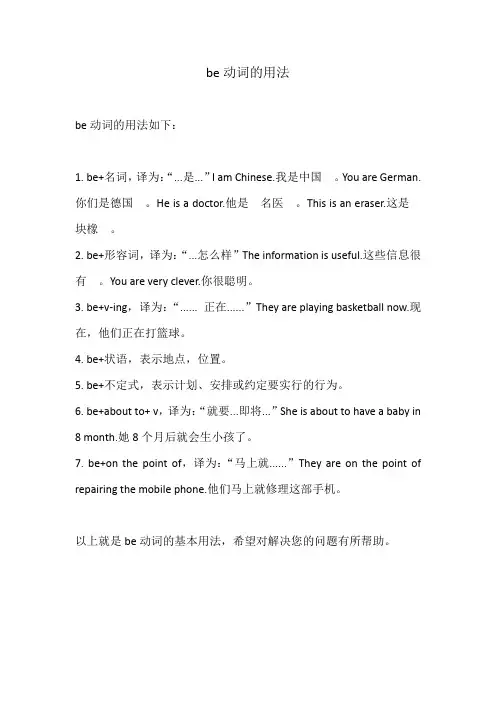
be动词的用法
be动词的用法如下:
1. be+名词,译为:“...是...”I am Chinese.我是中国⼈。
You are German.你们是德国⼈。
He is a doctor.他是⼈名医⼈。
This is an eraser.这是⼈块橡⼈。
2. be+形容词,译为:“...怎么样”The information is useful.这些信息很有⼈。
You are very clever.你很聪明。
3. be+v-ing,译为:“...... 正在......”They are playing basketball now.现在,他们正在打篮球。
4. be+状语,表示地点,位置。
5. be+不定式,表示计划、安排或约定要实行的行为。
6. be+about to+ v,译为:“就要...即将...”She is about to have a baby in 8 month.她8个月后就会生小孩了。
7. be+on the point of,译为:“马上就......”They are on the point of repairing the mobile phone.他们马上就修理这部手机。
以上就是be动词的基本用法,希望对解决您的问题有所帮助。
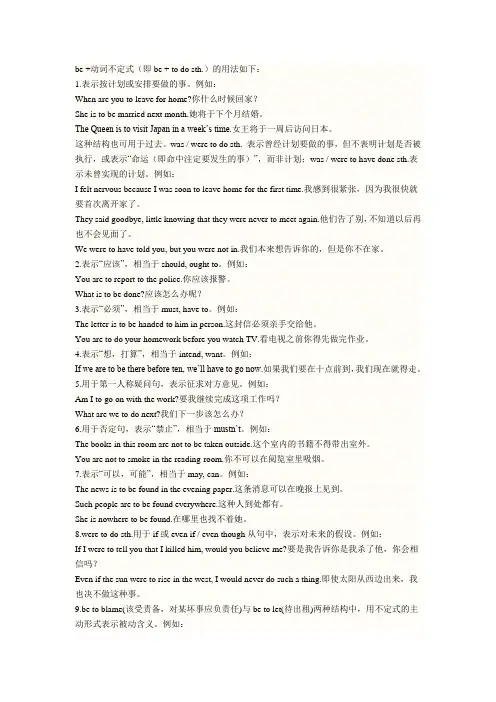
be +动词不定式(即be + to do sth.)的用法如下:1.表示按计划或安排要做的事。
例如:When are you to leave for home?你什么时候回家?She is to be married next month.她将于下个月结婚。
The Queen is to visit Japan in a week’s time.女王将于一周后访问日本。
这种结构也可用于过去。
was / were to do sth. 表示曾经计划要做的事,但不表明计划是否被执行,或表示“命运(即命中注定要发生的事)”,而非计划;was / were to have done sth.表示未曾实现的计划。
例如:I felt nervous because I was soon to leave home for the first time.我感到很紧张,因为我很快就要首次离开家了。
They said goodbye, little knowing that they were never to meet again.他们告了别,不知道以后再也不会见面了。
We were to have told you, but you were not in.我们本来想告诉你的,但是你不在家。
2.表示“应该”,相当于should, ought to。
例如:You are to report to the police.你应该报警。
What is to be done?应该怎么办呢?3.表示“必须”,相当于must, have to。
例如:The letter is to be handed to him in person.这封信必须亲手交给他。
You are to do your homework before you watch TV.看电视之前你得先做完作业。
4.表示“想,打算”,相当于intend, want。
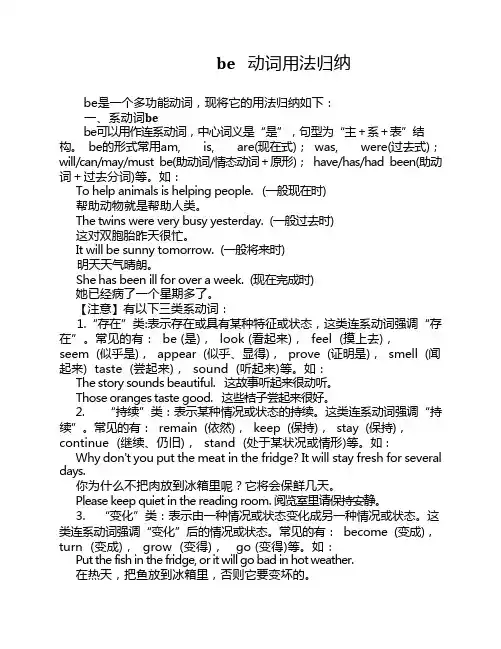
be动词用法归纳be是一个多功能动词,现将它的用法归纳如下:一、系动词bebe可以用作连系动词,中心词义是“是”,句型为“主+系+表”结构。
be的形式常用am, is, are(现在式); was, were(过去式);will/can/may/must be(助动词/情态动词+原形); have/has/had been(助动词+过去分词)等。
如:To help animals is helping people. (一般现在时)帮助动物就是帮助人类。
The twins were very busy yesterday. (一般过去时)这对双胞胎昨天很忙。
It will be sunny tomorrow. (一般将来时)明天天气晴朗。
She has been ill for over a week. (现在完成时)她已经病了一个星期多了。
【注意】有以下三类系动词:1.“存在”类:表示存在或具有某种特征或状态,这类连系动词强调“存在”。
常见的有: be (是), look (看起来), feel (摸上去),seem (似乎是), appear (似乎、显得), prove (证明是), smell (闻起来) taste (尝起来), sound (听起来)等。
如:The story sounds beautiful. 这故事听起来很动听。
Those oranges taste good. 这些桔子尝起来很好。
2. “持续”类:表示某种情况或状态的持续。
这类连系动词强调“持续”。
常见的有: remain (依然), keep (保持), stay (保持),continue (继续、仍旧), stand (处于某状况或情形)等。
如 : Why don't you put the meat in the fridge? It will stay fresh for several days.你为什么不把肉放到冰箱里呢?它将会保鲜几天。
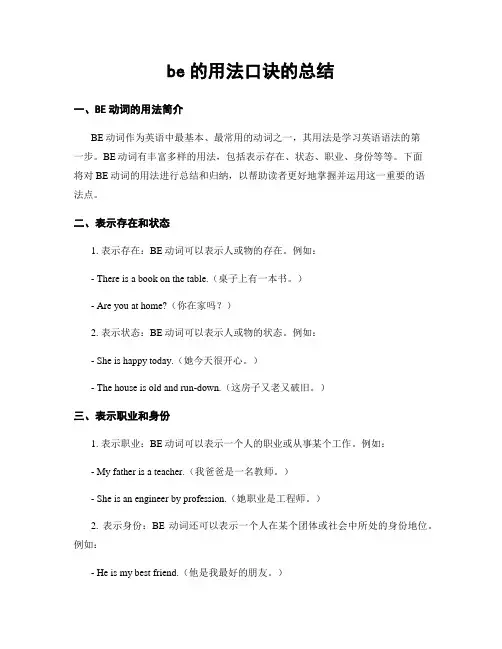
be的用法口诀的总结一、BE动词的用法简介BE动词作为英语中最基本、最常用的动词之一,其用法是学习英语语法的第一步。
BE动词有丰富多样的用法,包括表示存在、状态、职业、身份等等。
下面将对BE动词的用法进行总结和归纳,以帮助读者更好地掌握并运用这一重要的语法点。
二、表示存在和状态1. 表示存在:BE动词可以表示人或物的存在。
例如:- There is a book on the table.(桌子上有一本书。
)- Are you at home?(你在家吗?)2. 表示状态:BE动词可以表示人或物的状态。
例如:- She is happy today.(她今天很开心。
)- The house is old and run-down.(这房子又老又破旧。
)三、表示职业和身份1. 表示职业:BE动词可以表示一个人的职业或从事某个工作。
例如:- My father is a teacher.(我爸爸是一名教师。
)- She is an engineer by profession.(她职业是工程师。
)2. 表示身份:BE动词还可以表示一个人在某个团体或社会中所处的身份地位。
例如:- He is my best friend.(他是我最好的朋友。
)- They are members of the club.(他们是俱乐部的成员。
)四、表示时态和语态1. 表示时态:BE动词可以用来构成各种时态。
例如:- I am reading a book.(我正在读一本书。
)- She was studying when the phone rang.(电话响的时候她正在学习。
)2. 表示语态:BE动词还可以用来构成被动语态。
例如:- The dog was adopted by a kind family.(这只狗被一家善良的人领养了。
)- The cake will be made by my mother.(这个蛋糕将会由我妈妈制作。
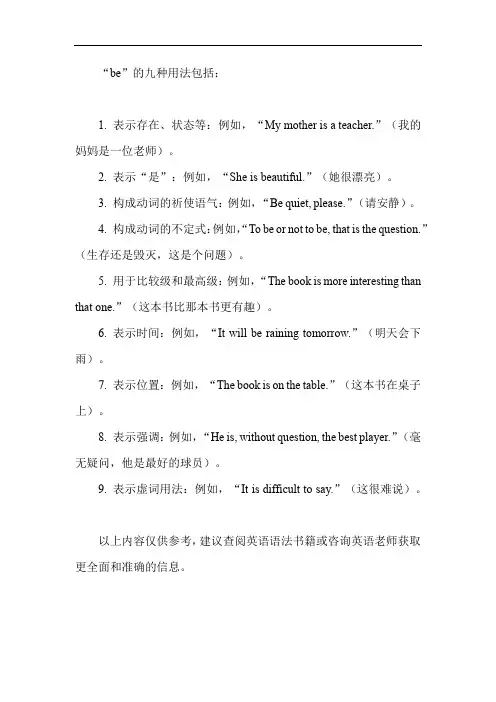
“be”的九种用法包括:
1. 表示存在、状态等:例如,“My mother is a teacher.”(我的妈妈是一位老师)。
2. 表示“是”:例如,“She is beautiful.”(她很漂亮)。
3. 构成动词的祈使语气:例如,“Be quiet, please.”(请安静)。
4. 构成动词的不定式:例如,“To be or not to be, that is the question.”(生存还是毁灭,这是个问题)。
5. 用于比较级和最高级:例如,“The book is more interesting than that one.”(这本书比那本书更有趣)。
6. 表示时间:例如,“It will be raining tomorrow.”(明天会下雨)。
7. 表示位置:例如,“The book is on the table.”(这本书在桌子上)。
8. 表示强调:例如,“He is, without question, the best player.”(毫无疑问,他是最好的球员)。
9. 表示虚词用法:例如,“It is difficult to say.”(这很难说)。
以上内容仅供参考,建议查阅英语语法书籍或咨询英语老师获取更全面和准确的信息。
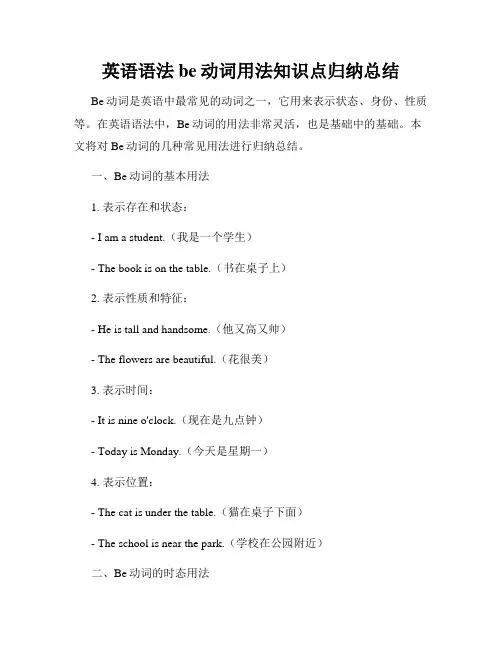
英语语法be动词用法知识点归纳总结Be动词是英语中最常见的动词之一,它用来表示状态、身份、性质等。
在英语语法中,Be动词的用法非常灵活,也是基础中的基础。
本文将对Be动词的几种常见用法进行归纳总结。
一、Be动词的基本用法1. 表示存在和状态:- I am a student.(我是一个学生)- The book is on the table.(书在桌子上)2. 表示性质和特征:- He is tall and handsome.(他又高又帅)- The flowers are beautiful.(花很美)3. 表示时间:- It is nine o'clock.(现在是九点钟)- Today is Monday.(今天是星期一)4. 表示位置:- The cat is under the table.(猫在桌子下面)- The school is near the park.(学校在公园附近)二、Be动词的时态用法1. 现在时态:- 主语+am/is/are+其他。
例如:- I am studying English.(我正在学英语)- She is a doctor.(她是一名医生)- They are playing football.(他们正在踢足球)2. 过去时态:- 主语+was/were+其他。
例如:- I was tired yesterday.(我昨天很累)- They were at home last night.(他们昨晚在家)3. 将来时态:- 主语+will be+其他。
例如:- She will be here tomorrow.(她明天会在这里)- We will be on vacation next week.(我们下周将要度假)三、Be动词的否定形式1. 现在时态的否定形式:- 主语+am not/isn't/aren't+其他。
例如:- I am not a doctor.(我不是医生)- It isn't raining.(现在没有下雨)- They aren't watching TV.(他们没在看电视)2. 过去时态的否定形式:- 主语+wasn't/weren't+其他。
英语中be动词的用法大全一、系动词be作为系动词(也叫连系动词,link verb)的be,是英语学习者接触最早的用法,而且其用法也很多。
其基本含义为“是”,基本用法结构为“主语+be+表语”,也就是我们常说的主系表结构,其中的表语一般都由名词、形容词、数词或表地点、时间等的短语来充当。
系动词be有各种时态的变化,也会和情态动词连用。
(一)be的时态变化系动词be会有一般现在时、一般过去时、一般将来时、现在完成时、过去完成时等的时态变化。
如:•He is a student.•They were in the park yesterday.•It will be cloudy tomorrow.•He has been ill for six days.•It had been three hours before sheleft the hat shop.(二)be与情态动词的连用其用法为:情态动词+系动词be原形。
如:•It must be Lucy's book. Her name ison the cover.•It can be very difficult for us tomemorize too many words within such ashort time.•She should be here on timetomorrow.更多有关系动词的用法,大家可以戳这里:一站式珍藏:英语九大词类二、助动词be作为助动词,be没有具体含义,而是与主要动词一起构成句子的谓语动词。
这种情况下,be主要用来构成进行时和被动语态。
(一)进行时态中的be此时,be可以与主要动词的现在分词一起,构成各种进行时态。
如:•He is reading in the library now. (现在进行时)•She was swimming in the river thistime yesterday. (过去进行时)•They will be arriving in Beijingtomorrow. (将来进行时)•We have been learning English forten years. (现在完成进行时)(二)被动语态中的be助动词be能够与主要动词的过去分词一起构成被动语态,即be done结构。
be的所有形式及其用法“be”的所有形式及其用法1. 动词“be”是英语中最基础,同时也是最常用的动词之一。
它有多种形式,包括am, is, are, was, were, been, being。
下面将一一解释这些形式的用法。
2. “be”主要用来表示存在,状态或性质。
例如,在现在时态中,主语与am, is, are 连用,表示当前的状态或性质。
- I am tired.(我累了。
)- He is intelligent.(他聪明。
)- They are from Canada.(他们来自加拿大。
)3. 在过去时态中,使用was和were来描述过去的状态或性质。
- She was busy yesterday.(她昨天很忙。
)- We were happy at the party.(我们在聚会上很开心。
)4. “be”也可以用作连系动词,连接主语与表语(通常是形容词或名词)。
- She is a doctor.(她是一名医生。
)- The flowers are beautiful.(这些花很美丽。
)5. “be”还可以用来表示位置或方位。
- The book is on the table.(书在桌子上。
)- The cat is under the bed.(猫在床下。
)6. 作为情态动词的一种,be有时可用来表示命令、建议、禁止等情况。
- Be quiet!(安静!)- You should be careful.(你应该小心。
)- Smoking is not allowed.(禁止吸烟。
)7. 进行时态中,be后接动词的现在分词(-ing),表示正在进行的动作。
- They are playing basketball.(他们正在打篮球。
)- She is dancing in the living room.(她正在客厅跳舞。
)8. 被动语态中,be后接过去分词,表示动作的接受者。
be+不定式动词“be+不定式动词”在不同情况下,可以表示很多种不同的语义。
下面便是其中九种:一、表示坚决的命令。
例如:1. This naughty boy is to stay here until the class is over.2. No one is to enter this building without the permission of the security guard.二、表示“计划”或“安排的事项”。
例如:3. Betty is to be married soon.4. An insurance agent is to meet us this afternoon.三、表示“可能性”。
例如:5. Are you to pay the debt for your wife?6. The lovely puppy is nowhere to be found.四、表示“意图”或“打算”。
例如:7. If you are to be there on time, you had better hurry.8. If all of us are to remain friendly, we must be sincere with one another.五、表示“应该”。
例如:9. You have done so well. You are to be rewarded.10. Such nasty questions are to be avoided.六、表示“不可避免”。
例如:11. Anne was wondering what was to become of her boy friend, Tommy.12. The murderer was sentenced to life imprisonment and was never to see his family again.七、表示“假设”。
小学be动词的英语语法知识讲解编者按:be动词,意思和用法很多,一般的意思是:是,此种用法,有多种变化形式。
下面小编给大家了有关be动词的英语语法知识,一起来看看吧!be动词Be动词有多种变化形式,小学阶段只需要掌握am、is、are和它们的变化形式就可以了。
在这里,be动词作为系动词,出现在主系表结构中,一般翻译成是。
口诀:I(我)用am,You(你)用are,单数(她、他、它)用is,复数(我们、你们呢、他们)全用are。
句型结构:(主系表)主语+be动词+其他(肯定句)She is a teacher.她是一名老师。
主语+be动词+not+其他(否定句)She is not a teacher .她不是一名老师。
be动词+主语+其他(一般疑问句)Is she a teacher?她是一名老师吗?疑问词+be动词+主语+其他(特殊疑问句)Where is your teacher?你的老师在哪里?主语+be动词+其他,be动词+not+主语(反义疑问句)She is a teacher,isn't she?她是一名老师,不是吗?或主语+be动词+not+其他,be动词+主语(反义疑问句)She isn't a teacher,is she?她不是一名老师,是吗?10个句子轻松掌握be动词的用法Where is your book?你的书在哪里?Her sweater is pink.她的毛衣是粉色的。
I am a student.我是一名学生。
The book is in my schoolbag.这本书在我的书包里。
We were students five years ago. 五年前我们是学生。
Are you a worker?你是一名工人吗?Tom isn‘t at home.汤姆不在家。
My mother was a teacher last year. 我的妈妈去年是一名老师。
be+不定式是英语中常见的一种结构,关于它的用法现在总结如下:一、构成系表结构:1、表示目的,例如:The prize was to honour him for his great discoveries.这项奖励是为了对他的重大发现而表示的敬意。
2、对主语内容进行解释说明,例如:What you should do is (to) answer my questions.你所应该做的就是回答我的问题。
二、表示将来:1、表示按计划安排要发生的事情,例如:The president is to visit China next year.总统将于明年访问中国。
If we are to be there in time, we'll have to hurry up.如果我们想及时到达那里,就必须要赶快。
注:我们可以说:It's going to rain.但不能说:It's to rain.2、表示无法预见的结果或注定要发生的事情,例如:Better days are soon to follow.好日子就要到了。
三、构成虚拟语气:1、were to do 用于虚拟条件句中,表示对将来情况的虚拟。
例如:What would you do if war were to break out?假如战争爆发你会怎么做?2、was/were+不定式的完成式(=should+不定式的完成式)表示过去应该发生而未发生的动作,例如:We were to have been married last year。
我们本打算去年结婚的。
四、be 后的个别动词不定式的主动形式表示被动意义,例如:It's Jim who is to blame.该怪的是吉姆。
This house is to let.此房出租。
五、其他用法:1、表示命令,指令。
例如:You are not to bring any mobile communication means into the exam-room.任何移动通讯工具都不得带入考场。
be+不定式动词
“be+不定式动词”在不同情况下,可以表示很多种不同的语义。
下面便是其中九种:
一、表示坚决的命令。
例如:
1. This naughty boy is to stay here until the class is over.
2. No one is to enter this building without the permission of the security guard.
二、表示“计划”或“安排的事项”。
例如:
3. Betty is to be married soon.
4. An insurance agent is to meet us this afternoon.
三、表示“可能性”。
例如:
5. Are you to pay the debt for your wife?
6. The lovely puppy is nowhere to be found.
四、表示“意图”或“打算”。
例如:
7. If you are to be there on time, you had better hurry.
8. If all of us are to remain friendly, we must be sincere with one another.
五、表示“应该”。
例如:
9. You have done so well. You are to be rewarded.
10. Such nasty questions are to be avoided.
六、表示“不可避免”。
例如:
11. Anne was wondering what was to become of her boy friend, Tommy.
12. The murderer was sentenced to life imprisonment and was never to see his family again.
七、表示“假设”。
例如:
13. If I were to do it, I would do it well.
14. Even if you were to take a taxi now, you would not be able to arrive at your destination on time.
八、有“期待将来”的含意。
例如:
15. The actual usefulness of the newly invented equipment is still to be
determined.
16. Henry's appointment with the accountancy firm is yet to be confirmed.
九、有“必然会发生”的含意。
例如:
17. She did not think too much of her unkind acts. However, they were to be harmful to herself, too.
18. Tom wasn't worried about his head injury, but it was to be troublesome for him later.。